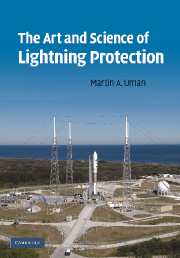Book contents
- Frontmatter
- Contents
- Preface
- 1 What is lightning?
- 2 Lightning damage
- 3 General methods for lightning protection: Faraday cages, topological shields; and more practical approaches: cone of protection and rolling sphere methods
- 4 Structure protection: air terminals and down conductors
- 5 Structure protection: grounding
- 6 Surge protection for electronics in low-voltage electrical systems
- 7 Humans and animals
- 8 Lightning warning
- 9 Airships, airplanes, and launch vehicles
- 10 Ships and boats
- 11 Trees
- 12 Overhead and underground power and communication lines
- 13 Lightning elimination
- 14 So, what do we know and what don't we know about lightning protection?
- Index
- References
8 - Lightning warning
Published online by Cambridge University Press: 17 November 2009
- Frontmatter
- Contents
- Preface
- 1 What is lightning?
- 2 Lightning damage
- 3 General methods for lightning protection: Faraday cages, topological shields; and more practical approaches: cone of protection and rolling sphere methods
- 4 Structure protection: air terminals and down conductors
- 5 Structure protection: grounding
- 6 Surge protection for electronics in low-voltage electrical systems
- 7 Humans and animals
- 8 Lightning warning
- 9 Airships, airplanes, and launch vehicles
- 10 Ships and boats
- 11 Trees
- 12 Overhead and underground power and communication lines
- 13 Lightning elimination
- 14 So, what do we know and what don't we know about lightning protection?
- Index
- References
Summary
Overview
In the previous chapter we discussed the effects of lightning on humans and animals, and we considered those situations and activities that are safe and those that are unsafe in a thunderstorm. In Section 7.1 we noted that in any outdoor group activity, like the positioning and movement of the spectators at a professional golf tournament, one individual should be designated as the responsible “weather person,” the primary person in charge of keeping track of the potential for lightning or other dangerous weather and of specifying when to get out of harm's way, using a plan that is already in place and tested. Only if one knows there is danger can appropriate action be taken to try to assure safety.
There are many situations in which it is not obvious that thunderstorms are approaching; for example, when the view of the storm and its lightning is obstructed or when nearby noise drowns out the sound of thunder. Nevertheless, the first line of defense in lightning warning is generally the visual observation of an approaching storm and the use of “flash to bang” thunder-ranging, that is, counting the time delay between seeing the light from the lightning and hearing its thunder. The time difference is about 5 seconds for each mile (about 3 seconds for each kilometer) of distance between the lightning and the observer, since sound travels about 1/5 mile (about 1/3 kilometer) per second while the light from a flash reaches the observer in a very small fraction of a second, that is, virtually instantaneously since light travels at 186 000 miles per second (300 000 kilometers per second).
- Type
- Chapter
- Information
- The Art and Science of Lightning Protection , pp. 134 - 151Publisher: Cambridge University PressPrint publication year: 2008



